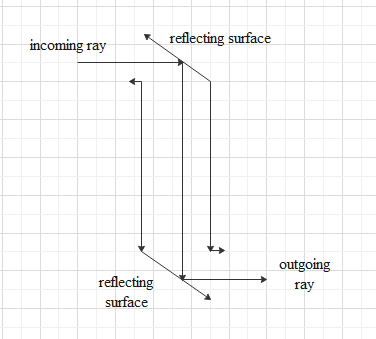
Periscope is built using the concept of
A. Refraction
B. Reflection
C. Polarization
D. Dispersion
Answer
490.2k+ views
Hint: Periscope is used to observe objects around an obstacle. The light from the objects enters the periscope from one end and emerges from the other end and enters into our eyes. We use mirrors inside a periscope to make the light bend in the direction we want to see it.
Complete answer:
Periscope is an instrument used for observation around or through an obstacle that prevents direct line-in-sight observation from the observer position.

The simplest type of periscope consists of an outer case and two mirrors at each end which are parallel to each other at an angle of ${{45}^{0}}$. The light from one end enters the periscope which then reflects at the first mirror and then on the second mirror before finally going out of the periscope to the observer's eyes.
So, the working principle of periscope is reflection of light through the two mirrors.
So, the correct answer is “Option B”.
Additional Information:
ince, the mirrors in the periscopes are at an angle of ${{45}^{0}}$, the light rays from an object falling on the telescope will incident at an angle of ${{45}^{0}}$. Then the reflecting light ray will also make an angle of ${{45}^{0}}$ with the normal because the angle of incidence is equal to the angle of reflection. This way we can make the light ray to travel parallel to the tube of the periscope and when it incident on the second mirror again it will make an angle of ${{45}^{0}}$ with the mirror and finally go out of the periscope.
Note:
We have discussed only the simplest form of periscope here. But we have other types of periscopes also. In some periscopes we use prisms instead of mirrors. Again, we can use the telescope system with the help of lenses inside a periscope to get magnification as well as a wide angle view of the objects.
Complete answer:
Periscope is an instrument used for observation around or through an obstacle that prevents direct line-in-sight observation from the observer position.

The simplest type of periscope consists of an outer case and two mirrors at each end which are parallel to each other at an angle of ${{45}^{0}}$. The light from one end enters the periscope which then reflects at the first mirror and then on the second mirror before finally going out of the periscope to the observer's eyes.
So, the working principle of periscope is reflection of light through the two mirrors.
So, the correct answer is “Option B”.
Additional Information:
ince, the mirrors in the periscopes are at an angle of ${{45}^{0}}$, the light rays from an object falling on the telescope will incident at an angle of ${{45}^{0}}$. Then the reflecting light ray will also make an angle of ${{45}^{0}}$ with the normal because the angle of incidence is equal to the angle of reflection. This way we can make the light ray to travel parallel to the tube of the periscope and when it incident on the second mirror again it will make an angle of ${{45}^{0}}$ with the mirror and finally go out of the periscope.
Note:
We have discussed only the simplest form of periscope here. But we have other types of periscopes also. In some periscopes we use prisms instead of mirrors. Again, we can use the telescope system with the help of lenses inside a periscope to get magnification as well as a wide angle view of the objects.
Recently Updated Pages
Master Class 10 General Knowledge: Engaging Questions & Answers for Success

Master Class 10 Computer Science: Engaging Questions & Answers for Success

Master Class 10 Science: Engaging Questions & Answers for Success

Master Class 10 Social Science: Engaging Questions & Answers for Success

Master Class 10 Maths: Engaging Questions & Answers for Success

Master Class 10 English: Engaging Questions & Answers for Success

Trending doubts
Explain the Treaty of Vienna of 1815 class 10 social science CBSE

The highest dam in India is A Bhakra dam B Tehri dam class 10 social science CBSE

Name the place where the Indian National Congress session class 10 social science CBSE

Name the place where Indian National Congress session class 10 social science CBSE

Name the largest artificial lake that was built in class 10 social science CBSE

Distinguish between coming together federations and class 10 social science CBSE




